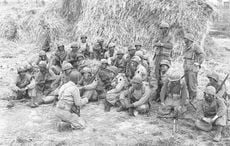1. Printers were barely able to print the Proclamation.
The printers of the Easter Proclamation did not have enough letter e’s so they used f’s and hammered off the bottom bar.
The antique printing press had to print the proclamation in two parts and there are numerous typographical problems and different fonts were used.
1,000 copies were printed of which about 15 remain, though some claim 30 but there were many bogus ones printed later.
2. Joseph Plunkett's sister did not like Michael Collins, called him a “Pup.”
The family of proclamation signatory Joseph Mary Plunkett was a famed one with noble ancestors.
However, his nephew remembers Plunkett’s sister taking a mighty dislike to Michael Collins before The Rising. Eoghan Plunkett told the Irish Times, “I have to explain to you that my mother knew Mick [Michael] Collins very well,” he says. “He had an office in her flat and she despised him. He was a pup, a nasty piece of work.”
“Whenever he came into their living room, the carpet on the livingroom floor was surrounded by a timber floor, but he walked on the timber part,” says Plunkett. “Why? Because it made more noise. That’s the sort of fellow that he was. She and he were both from west Cork; she recognized him for what he was.”
Was Collins was one of the greatest Irishmen? Plunkett laughs. “Not in our eyes.”
3. The son of a 1916 leader went on to rule the country.
The father of future Irish leader Garret FitzGerald took part in the uprising. Desmond FitzGerald and his wife married in 1911, moved to Brittany and then in 1913 to Irish-speaking Dingle in County Kerry, where he organized the newly-formed Irish Volunteers, according to Peter McDermott of the Irish Echo.
They had gone to Ireland to take part in the “national movement,” a cause distinct from that of the predominant Home Rule party. After being prohibited by the authorities from operating in Kerry, FitzGerald moved to Bray, Co. Wicklow, 15 miles from Dublin, where the family lived thereafter.
Mabel FitzGerald worked in Dublin for Cumann na mBan, whose offices didn’t have a typewriter, “She would go home to do the typing at night, having spent the day meeting people,” her son said.
She was involved in the first few days of the Rising. After she’d completed a couple of important missions for him, Patrick Pearse said: “You can’t have the parents of two small children here — you go home.”
Desmond FitzGerald had been put in charge of the food supplies on the third floor of the GPO, where the restaurant was, “Everybody came up to eat there,” said his son.
4. Another 1916 father and son led the Irish nation.
Another future leader whose son also became leader was W. T. Cosgrave, his son Liam, still living, became Irish leader in the 1970s. W. T. Cosgrave was Irish leader in the first post-civil war government.
He was widely criticized for allowing the execution of 77 political opponents and his reputation never recovered. His son Liam Cosgrave was Taoiseach from 1973 to 1977 and is still hale and hearty at 95, and he recently launched a new biography on his father.
5. Looting was a huge problem in Dublin during the Rising.
The regular unarmed police were withdrawn after several deaths and the poorest citizens took the opportunity to fill their coffers. 425 people were arrested as looters.
6. Off to the races as revolution broke out.
The reason Dublin was almost denuded of British officers on Easter Monday 1916 was because most of them were at the Fairyhouse Races, where Ireland’s most famous race, the Irish Grand National was being run. It was a huge fashion day at the track with everyone, especially the ladies, in their finery.
News of the insurrection eventually reached the racetrack and there was a rush to return to Dublin, but the officers were held up by a massive horse and carriage and automobile jam. When many got back to Dublin they could not get to their posts because of snipers.
7. Oldest living relative of the executed rebels is 102 years old.
The oldest survivor of those executed is Father Joseph Mallin, now 102 and in good health, son of Michael Mallin whom he visited in his death cell as a very young child.
Joseph Mallin was just two years old when his father, Michael, was executed at Kilmainham Gaol for his part in the Easter Rising. As Chief of Staff of the Irish Citizen Army, Michael Mallin was second-in-command to James Connolly.
Before he was shot, on May 8, 1916, Michael wrote to his family, telling his baby son: “Joseph, my little man, be a priest if you can.”
Joseph became a priest. He is now 102 years old and lives in Hong Kong. There he worked at the Wah Yan College, a Roman Catholic secondary school for boys run by the Society of Jesus, Ireland.
Joseph Mallin is the last surviving child of any of the Easter Rising leaders. In a letter dated July 2011, he recalled some of his memories of 1916 and the aftermath.
Fr Joseph also described a 2009 visit home to Ireland, and to Kilmainham Gaol, scene of his father’s execution.
“The young lady at the entrance mentioned the entrance fee. I couldn’t refrain from a wee joke. I said, ‘The first time I came here I didn’t have to pay entrance fee’ – but went on – “Ah, that time I was only two and a half years of age – and I was asleep.
“Later, when she was leading us round the prison and the group had dispersed, I told her who I was.” As he was just an infant, Fr Joseph remembers little of the year 1916, or the day he was first brought to Kilmainham.
“As I said to the young lady in Kilmainham, ‘I was asleep’. I know I was asleep on the metal stairway in the main hall. My sister told me that. A soldier came over and said he was very sorry for me. My first memory comes later.”
Father Joseph said his father or the events of Easter week were not common topics of conversation in the years that followed the executions as his mother did not want to burden him. “Perhaps it was wise of my mother in those years not to speak of my father. She was very wise. Mrs Pearse and Mrs Austin Stack held her in a certain sort of reverence,” he said.
Michael Mallin was survived by his wife Agnes, his three sons (including Joseph) and two daughters, the youngest of whom was not born until four months after his execution. Joseph explained: “The 1916 event took a toll on my mother’s health. I accidentally heard Surgeon Stokes say her breakdown in health was a ‘direct’ result of 1916.”
8. One brave priest attended all of the leaders’ executions.
Father Eugene McCarthy officially attended at each execution. He was roused from his bed each morning at 4am. After the prisoners were placed against the wall and the firing party fired, his duty was to anoint the body where it fell.
“On the morning of Joseph Plunkett’s execution he was taken away earlier than usual and told he was to perform the marriage ceremony of the prisoner and Grace Gifford prior to the execution.
Mrs Plunkett afterwards visited him in the presbytery, during which time the place was raided by the military.
“In giving a description of James Connolly’s execution Fr McCarthy told me that the prisoner, who was in a bad condition, elected to stand like the rest but failed. He was then tied to a chair but slumped so much that he overbalanced. Finally he was strapped to a stretcher and placed in a reclining position against the wall.
The sight left an indelible impression on Fr McCarthy. Describing the scene to me afterwards he said: “The blood spurted in the form of a fountain from the body, several streams shooting high into the air”.
“After the storm of executions had passed it was arranged to have Mass in the Richmond Barracks, where most of the rank and file were being held captive and in Kilmainham. By degrees the number of prisoners dwindled until we eventually had Mass for the last time in 1916 for William Partridge, who was far advanced in TB and who died the following week. The jail then closed until the advent of the Black and Tans.”
9. The final resting place of the executed leaders is not where you might think.
Many expect it is Glasnevin but not so, The military cemetery at Arbour Hill is the last resting place of 14 of the executed leaders of the insurrection of 1916. Among those buried there are Patrick Pearse, James Connolly and Major John McBride. The leaders were executed in Kilmainham and their bodies were then transported to Arbour Hill, where they were buried.
The graves are located under a low mound on a terrace of Wicklow granite in what was once the old prison yard. The grave site is surrounded by a limestone wall on which their names are inscribed in Irish and English. On the prison wall opposite the grave site is a plaque with the names of other people who gave their lives in 1916.
The adjoining Church of the Sacred Heart, which is the prison chapel for Arbour Hill prison, is maintained by the Department of Defence. At the rear of the church lies the old cemetery, where lie the remains of British military personnel who died in the Dublin area in the 19th and early 20th century.
10. No one really knows what the weather was like during the Rising.
What was the weather like at Easter 1916? We don't really know. The weather records from Trinity College Dublin from 1904 to 1959 were the official record. The observations were handwritten on broadsheet sized templates, which were issued by the Meteorological Office in London. At 9 a.m. and 9 p.m. daily, readings for atmospheric pressure, temperature, wind direction, wind speed, cloud cover and rainfall (among other data) were recorded. Each template sheet also had a field for ‘Remarks’, where observers could record additional information. Generally, an observer might record a thunderstorm, a gale or another unusual weather event in this field but on one occasion, something different was recorded.
In the ‘Remarks’ made by an observer at TCD in April 1916 he writes ‘Owing to the disturbances in Dublin the observations were not taken from 24th to end of month.’ It was, of course, on the 24th of April 1916, that Patrick Pearse stood outside the G.P.O to read the Proclamation of the Irish Republic. The ‘disturbances’ to which our observer referred was the start of the Easter Rising. The meteorological records did not resume again until May 18, 1916. For a period of almost four weeks, weather recording stopped.




Comments